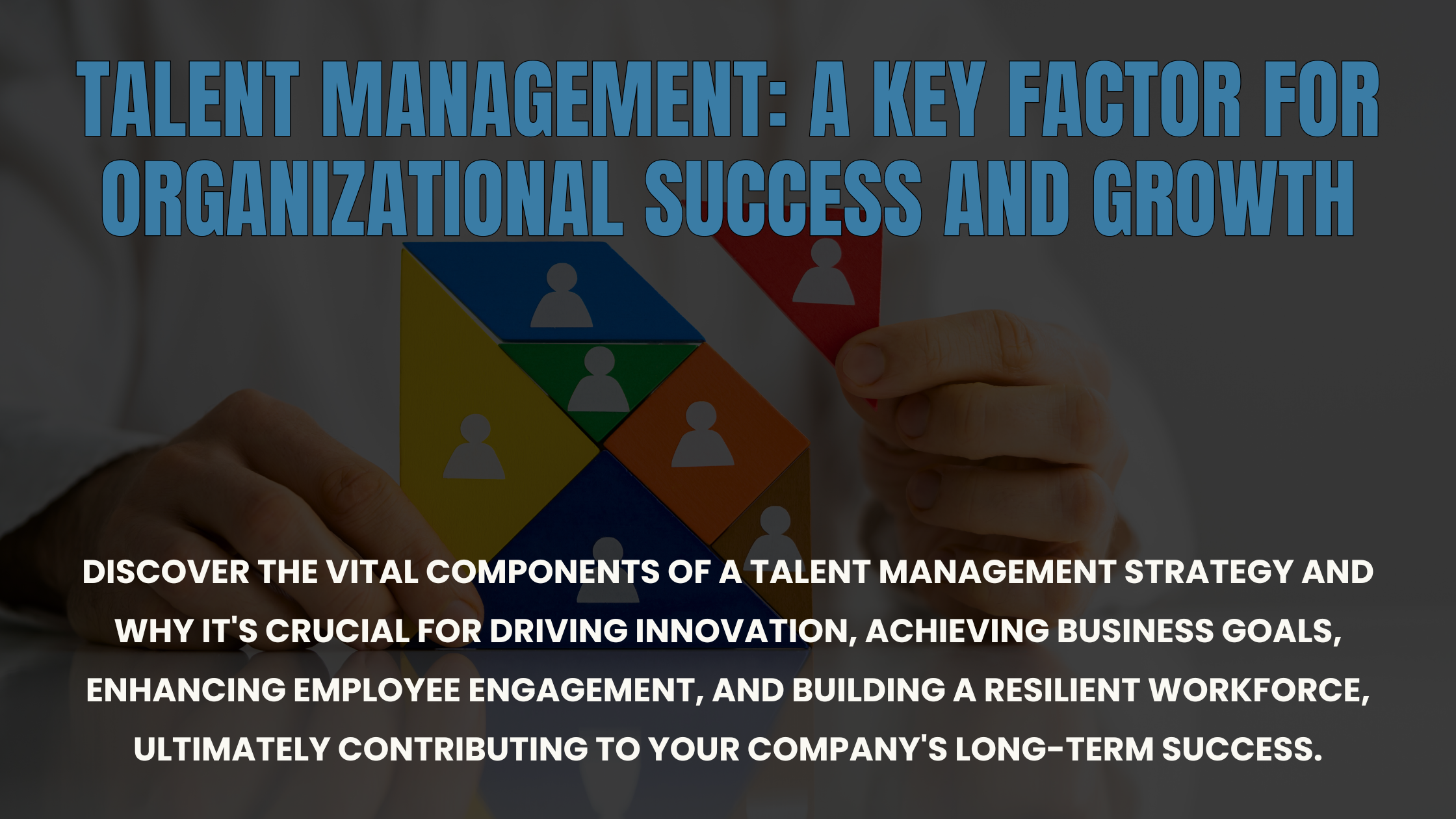Talent Management: A Key Factor for Organizational Success and Growth
Posted: January 19, 2024


As a private business owner, you know that your employees are your most valuable asset. They are the talent who drive your business forward, deliver quality products and services, and satisfy your customers. Having the right people in the right roles can propel results and define a company’s competitive edge, and “is an essential imperative that is critical for business success”, according to Sue Cummings, former head of HR at TD Bank Group. However, finding, developing, and keeping the right talent can be challenging, especially in a competitive and dynamic market. That is why you need a talent management strategy.
Outlined below are the key elements of a talent management strategy, many of which are often overlooked by Management who relegate some of these components as “peripheral”. Sue believes that “this is a mistake because having a plan to step into an increasingly mature approach over time is a key business value driver – and one that is scrutinized by third parties during a liquidity event”.
A talent management strategy is a plan that outlines how you will attract, develop, and retain your workforce. It is aligned with your vision, mission, values, and goals, and drives your competitive advantage.
In the dynamic and competitive landscape of today’s business world, effective talent management is an absolute necessity. It is the key to unlocking the full potential of a workforce, driving innovation, and ensuring long-term success. By investing in talent management strategies, private businesses can build resilient, engaged, and high-performing teams that can help them weather challenging times and propel them to new heights. Successful talent management provides numerous benefits, including:
Talent management is instrumental in fostering innovation within any business (AIHR). By identifying and nurturing individuals with diverse skill sets, experiences, and perspectives, companies can create a dynamic workforce capable of generating fresh ideas and adapting to changing market trends. Innovation is the lifeblood of any successful company, and a well-managed talent pool is essential for staying ahead of the curve.
For a business to thrive, it is critical that employees at all levels are aligned with its strategic goals and objectives (Rizolve Partners). Talent management ensures that the right people, with the right skills, are in the right positions to drive the company forward. This alignment maximizes efficiency and improves decision-making processes. Talent management also helps you to measure and improve the performance and impact of your employees, and to identify and address any gaps or risks. By doing so, you can optimize your resources, increase your effectiveness, and enhance your profitability and growth.
Engaged employees are more likely to be productive, committed, and aligned with the organization’s goals (HBR). Talent management involves creating an environment where employees feel valued, supported, and encouraged to develop their skills. When employees believe in their potential for growth within the company, they are more likely to invest time and effort in their roles, resulting in increased productivity and overall business success.
Talent management goes beyond hiring skilled individuals; it involves planning for the long term. By identifying and developing potential leaders within the organization, businesses can create a pipeline of talent capable of taking on key roles. This succession planning mitigates the risks associated with sudden departures or unexpected changes in leadership, ensuring continuity and resilience (McKinsey).
High turnover rates can be detrimental to the success of any business. Recruiting and training new employees incur significant costs, both in terms of time and resources. Employee turnover is a significant issue for many businesses in North America, as it can result in high costs, low productivity, and low morale. The average cost of replacing an employee can range from 0.5 to 2 times the employee’s annual salary and even more for C-level positions (Gallup). Talent management focuses on retaining valuable employees by offering career development opportunities, mentorship programs, and a positive work environment. Satisfied and engaged employees are more likely to stay with the company, reducing turnover and preserving institutional knowledge.
In today’s interconnected world, a company’s reputation as an employer plays a crucial role in attracting top talent (HBR). Effective talent management not only focuses on internal development but also emphasizes creating a positive employer brand. It helps you to foster a culture of collaboration, innovation, and diversity, and to align your employees with your values and goals. A company known for valuing its employees, nurturing growth, and providing a supportive work environment will naturally attract high-calibre professionals, giving the business a competitive advantage in the talent market.

A well-defined talent management strategy is the cornerstone of building a workforce that not only meets your current business needs but also ensures sustained success in the future. Some of the key components of an effective talent management strategy are:
Before embarking on the development of a talent management strategy, it’s crucial to understand the existing talent within your organization. Conduct a comprehensive talent assessment to identify skills, competencies, and potential gaps. This analysis sets the foundation for targeted recruitment, development, and succession planning.
Your talent management strategy should seamlessly integrate with the overall strategic objectives of the business. Identify the critical skills, competencies, and behaviours for different roles and levels. And clearly define how the acquisition, development, and retention of talent contribute to achieving long-term goals. Identify key performance indicators that will measure the success of your talent management efforts.
Develop a robust succession plan that identifies critical roles within the organization. Establish a talent pipeline by grooming internal candidates for key positions. This proactive approach ensures a smooth transition in leadership and minimizes disruptions caused by unexpected departures.
Craft a recruitment strategy that goes beyond traditional methods. Leverage online platforms, social media, and professional networks to attract top-tier talent. Utilize data and technology to optimize the recruitment process and to ensure a positive candidate experience that showcases your company’s culture and brand. Include clear and consistent criteria for selecting and evaluating candidates. Once recruited, streamline the onboarding process to integrate new hires into the company culture, mission, and workflows.
Foster a culture of continuous learning within your organization. Offer regular training programs to enhance employee skills and knowledge. Provide opportunities for professional development and career advancement, creating an environment where employees feel invested in their growth.
Cultivate a positive workplace culture that values diversity, equity, inclusion, and employee well-being. Promote open communication channels, encourage collaboration, recognize and reward achievements, and celebrate successes. A positive work environment contributes significantly to employee satisfaction and retention.
Establish clear performance expectations and goals for employees. Empower your employees to make decisions and take ownership of their work, and provide them with autonomy, support, and the resources required to achieve their objectives. Implement regular performance reviews and feedback mechanisms to track progress. Provide constructive feedback and support for employees’ professional growth to ensure a continuous improvement mindset.
Regularly gauge employee satisfaction through engagement surveys. Address concerns promptly and implement retention strategies, such as career development opportunities, flexible work arrangements, and competitive compensation packages. A satisfied and engaged workforce is more likely to stay committed to the organization.
Provide compensation and benefits that are attractive and meaningful for your employees. Compensation and benefits should be based on market research and benchmarking and should be linked to the performance and potential of the employees, reflecting their contribution and value to the organization.
Recognize that the business landscape is constantly evolving. Periodically review and update your talent management strategy to stay aligned with changing business needs. Being agile and adaptable ensures that your strategy remains relevant and effective over time.
Developing a robust talent management strategy is a critical investment in the future success of your business. By conducting thorough assessments, aligning with strategic objectives, and implementing effective practices, you can build a talented, engaged, and resilient workforce that optimizes your human capital, enhances your organizational performance, and propels your organization toward sustained growth and prosperity.
